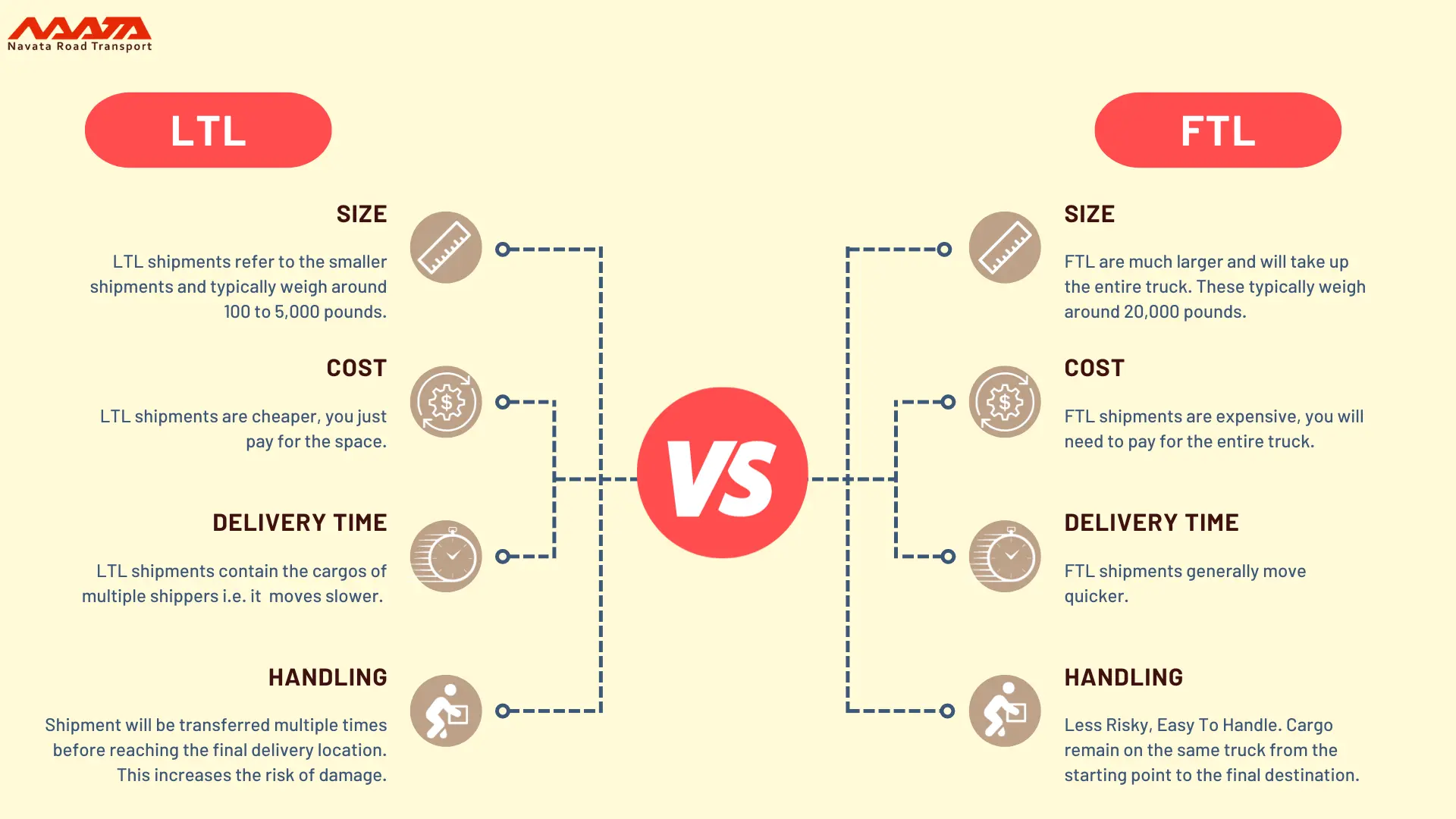4 Key Difference Between LTL and FTL: Pros and Cons LTL & FTL
Table of Contents
LTL and FTL Explained
Shipping is an essential component of any business that includes the movement of goods from one point to another. The shipping process, whether for importing raw materials or exporting finished goods, must be efficient and cost-effective. LTL (Less Than Truckload) and FTL (Full Truckload) shipping are two prominent shipping techniques.
LTL is a shipping technique in which several shipments from various companies are pooled and transported in a single truck. Because the expense is shared by numerous organisations, this is a cost-effective option to deliver smaller shipments. LTL shipments typically weigh between 150 to 10,000 pounds, and the pricing is determined by the shipment’s weight, size, and distance.
FTL, on the other hand, is a shipping method where the entire truck is dedicated to one shipment. This is typically used for larger shipments that weigh more than 10,000 pounds. FTL shipments are usually more expensive than LTL shipments because the entire truck is dedicated to one shipment.

Also Read: FTL, LTL, and PTL Explained
Difference Between LTL and FTL
There are many differences between the two types of shipments. However, the main points can be broken into four main differences. These are:
Size
Whenever talking about shipments, the first thing that you must take into account is the size of your freight. The terms, Less-than-truckload and Full-Truckload are self-explanatory. They stand for exactly what they say. LTL shipments refer to the smaller shipments and typically weigh around 100 to 5,000 pounds. It is natural that these small freights will not take up the entire space available inside a truck, thus, leaving space behind for other freights as well.
FTL, on the other hand, are much larger and will take up the entire truck. These typically weigh around 20,000 pounds or even more than that. The shipments lying between the range of 5,000 to 10,00 pounds can be moved by either LTL or FTL. In case they are being moved by LTL, these are referred to as “volume LTL” shipments; and when they move FTL, they are called as “partial TL” shipments.
Also Read: Discussing 6 Supply Chain Trends For 2023
Cost
It is no secret that LTL shipments are cheaper. This is because these shipments are smaller and require less space, thus, leaving room for other freights. Therefore, you only need to pay for the space that your freight takes up. On the other hand, in case of FTL shipments, you will need to pay for the entire truck.
Delivery Time
FTL shipments generally move quicker. This is because of the fact that FTL shipments only carry your product. Therefore, it will directly move from the starting point to the destination. On the contrary, as LTL shipments contain the cargos of multiple shippers, they will need to make multiple stops before reaching the final destination. Therefore, if you need to get something shipped quickly, FTL is the way to go.
Handling
One of the major benefits of FTL shipments is that your products will remain on the same truck from the starting point to the final destination. They will not be transferred from one truck to another. Therefore, there is less risk of your good getting damaged. While in case of LTL, your shipment will be transferred multiple times before reaching the final delivery location. This increases the risk of damage and even missing items.

Advantages and Disadvantages of LTL
Advantages of LTL Shipping
Cost Efficiency
LTL shipping is a cost-effective option for businesses with smaller loads or shipments that don’t require an entire truck. Since multiple shipments from different shippers can be consolidated onto a single truck, companies can share transportation costs, reducing the overall expense.
Flexibility
LTL carriers offer flexibility in accommodating various shipment sizes and shapes. This is particularly advantageous for businesses with irregular or fluctuating shipping volumes.
Reduced Carbon Footprint
LTL shipping can be environmentally friendly since it optimizes truck space usage, resulting in fewer vehicles on the road and decreasing emissions per shipment.
Access to a Network
LTL carriers typically have extensive transportation networks, making it easier for businesses to reach various destinations, even those that may be harder to access with FTL.
Disadvantages of LTL Shipping
Longer Transit Times
Due to the multiple stops and handling of various shipments on a single truck, LTL shipments may have longer transit times than FTL shipments.
Increased Risk of Damage
With multiple shipments on the same truck, there is a higher risk of cargo damage or loss during loading, unloading, and transportation.
Less Control
Businesses may need more control over the handling and scheduling LTL shipments, as the carrier determines the route and delivery times based on their consolidated shipments.
Advantages and Disadvantages of FTL
Advantages of FTL Shipping
Faster Transit Times
FTL shipments are typically quicker because there are no intermediate stops or handling of other cargo during transit. This is advantageous for businesses that require time-sensitive deliveries.
Reduced Risk of Damage
With FTL, there is less risk of cargo damage or loss since the shipment is loaded onto the truck and unloaded only at its final destination.
Predictable Scheduling
Companies have more control over the scheduling and routing of FTL shipments, allowing for precise coordination of deliveries.
Ideal for Large Shipments
FTL is the preferred choice when shipping large quantities of goods that require the entire truck’s capacity, ensuring efficient space utilization.
Disadvantages of FTL Shipping
Higher Cost
FTL shipping can be expensive, especially for businesses with smaller shipments that only partially utilize the truck’s capacity.
Limited Flexibility
FTL shipments require a commitment to the entire truckload, making it less flexible for companies with fluctuating shipping volumes.
Environmental Impact
FTL shipments may have a higher ecological impact due to the larger trucks used and less efficient use of space, resulting in increased emissions per shipment.
Conclusion
In conclusion, both LTL and FTL shipping methods have benefits and drawbacks, and the decision between the two is influenced by a number of variables, including the size of the shipment, the cost, and the needed delivery time. It’s crucial for business owners to assess their shipping demands and select a delivery method that suits them.
Whether you pick LTL or FTL shipping, it’s critical to work with a dependable carrier with a track record of delivering items on time and in good shape. You can ensure that your items are carried safely and securely by selecting a reliable carrier, which will eventually assist to boost your bottom line.
Thanks For Reading: 4 Key Difference Between LTL and FTL: Understanding LTL and FTL
Powered By 360Presence




